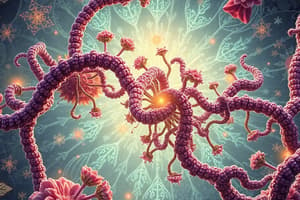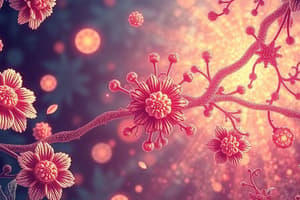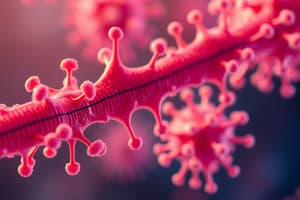Podcast
Questions and Answers
What is the role of an agonist in drug-receptor interactions?
What is the role of an agonist in drug-receptor interactions?
- It shifts the receptor state to inactive.
- It activates a receptor to produce a similar effect as a physiological signal. (correct)
- It has no effect on the receptor.
- It prevents receptor activation.
How do antagonists influence receptor activity?
How do antagonists influence receptor activity?
- They convert inactive receptors to active ones.
- They activate the receptor.
- They increase the receptor's sensitivity.
- They block the receptor without producing an active signal. (correct)
What does pharmacodynamics primarily describe?
What does pharmacodynamics primarily describe?
- The chemical structure of drugs
- The synthesis of biological molecules
- The distribution of drugs in the body
- The actions of a drug on the body (correct)
What is the consequence of agonist binding to a receptor?
What is the consequence of agonist binding to a receptor?
Which factor is NOT mentioned as influencing drug-receptor interactions?
Which factor is NOT mentioned as influencing drug-receptor interactions?
What determines the magnitude of the biological effect of a drug?
What determines the magnitude of the biological effect of a drug?
What type of drug would increase the activity of a receptor?
What type of drug would increase the activity of a receptor?
What is true about partial agonists?
What is true about partial agonists?
A dose-response curve of a drug is typically characterized as what type of function?
A dose-response curve of a drug is typically characterized as what type of function?
What describes the dose-response relationship?
What describes the dose-response relationship?
Which of the following terms is used to describe the maximum response achievable by a drug?
Which of the following terms is used to describe the maximum response achievable by a drug?
What is the relationship between drug concentration and response known as?
What is the relationship between drug concentration and response known as?
What is a key feature of receptor states?
What is a key feature of receptor states?
Which statement accurately describes tolerance in pharmacodynamics?
Which statement accurately describes tolerance in pharmacodynamics?
What is a characteristic of antagonists in relation to agonists?
What is a characteristic of antagonists in relation to agonists?
Which of the following best describes the concept of selectivity in drug action?
Which of the following best describes the concept of selectivity in drug action?
What defines spare receptors in pharmacology?
What defines spare receptors in pharmacology?
How do full agonists compare to partial agonists in terms of efficacy?
How do full agonists compare to partial agonists in terms of efficacy?
What is the primary role of antagonists when an agonist is present?
What is the primary role of antagonists when an agonist is present?
What effect do competitive antagonists have on the agonist dose-response curve?
What effect do competitive antagonists have on the agonist dose-response curve?
What distinguishes an inverse agonist from a regular agonist?
What distinguishes an inverse agonist from a regular agonist?
What happens when both a competitive antagonist and an agonist are present?
What happens when both a competitive antagonist and an agonist are present?
What is the function of allosteric sites on a receptor?
What is the function of allosteric sites on a receptor?
How is the efficacy of a drug determined in relation to receptor occupancy?
How is the efficacy of a drug determined in relation to receptor occupancy?
What is the main function of tyrosine kinase linked receptors?
What is the main function of tyrosine kinase linked receptors?
Which of the following statements about ligand-gated ion channels is true?
Which of the following statements about ligand-gated ion channels is true?
What are the subunits of G proteins composed of?
What are the subunits of G proteins composed of?
Which of the following correctly describes the role of the α subunit in G-protein coupled receptors?
Which of the following correctly describes the role of the α subunit in G-protein coupled receptors?
What occurs when the extracellular ligand binding domain of enzyme-linked receptors is activated?
What occurs when the extracellular ligand binding domain of enzyme-linked receptors is activated?
Which type of channels opens in response to a specific change in membrane voltage?
Which type of channels opens in response to a specific change in membrane voltage?
Which is a characteristic of G-protein coupled receptors?
Which is a characteristic of G-protein coupled receptors?
What is the significance of ligands being lipophilic?
What is the significance of ligands being lipophilic?
What occurs when an agonist binds to a G-protein coupled receptor?
What occurs when an agonist binds to a G-protein coupled receptor?
What is the primary consequence of activating adenylyl cyclase in GPCR pathways?
What is the primary consequence of activating adenylyl cyclase in GPCR pathways?
Which G-protein subunit is responsible for inhibiting adenylyl cyclase?
Which G-protein subunit is responsible for inhibiting adenylyl cyclase?
What triggers the dissociation of the α subunit from the G-protein coupled receptor?
What triggers the dissociation of the α subunit from the G-protein coupled receptor?
What is the process called when a receptor becomes desensitized after repeated agonist exposure?
What is the process called when a receptor becomes desensitized after repeated agonist exposure?
Which action does Gαq subunit primarily perform in GPCR signaling?
Which action does Gαq subunit primarily perform in GPCR signaling?
What is one of the main downstream effects when cAMP acts as a second messenger?
What is one of the main downstream effects when cAMP acts as a second messenger?
How does Gs affect adenylyl cyclase in the context of GPCR signaling?
How does Gs affect adenylyl cyclase in the context of GPCR signaling?
Study Notes
Learning Objectives
- Describe receptor physiology and different receptor types.
- Explain key steps in signal transduction, including second messenger involvement.
- Understand how ligands or drugs regulate each receptor type.
- Establish the relationship between drug concentration and biological response.
- Analyze drug-response curves, including hyperbolic and log-transformed representations.
- Define key terms: agonist, antagonist, partial agonist, right-shift, left-shift, antagonism.
- Differentiate concepts such as potency, maximal efficacy, tolerance, tachyphylaxis, and selectivity.
Drug Receptors
- Pharmacodynamics investigates how drugs interact with the body and affect pharmacologic responses.
- Receptors determine the specificity and quantitative relationship between the dose of a drug and its effects.
- Molecular characteristics (size, shape, charge) of drugs influence their binding affinity to receptors.
Dose-Response Relationship
- Drug efficacy is illustrated in dose-response curves, which plot drug concentration against biological response.
- Affinity between receptors and drugs determines the concentration required for a response.
- Spare receptors are those exceeding the amount necessary for a full effect, influencing therapeutic outcomes.
Agonists and Antagonists
- Agonists activate receptors, mimicking physiological signals.
- Antagonists prevent receptor activation by not inducing a signal; they block agonist action by occupying binding sites.
- Partial agonists activate receptors but produce a lesser effect compared to full agonists.
Signal Transduction
- Drug-receptor binding triggers signal transduction, producing cellular responses through secondary messengers.
- Receptors can exist in inactive (R) and active (R*) states; agonists shift the equilibrium to the R* state, generating biological effects.
- Partial agonists shift the equilibrium but to a lesser extent than full agonists.
Inverse Agonists
- Inverse agonists produce effects opposite to agonists upon binding to the receptor, while antagonists have no intrinsic activity.
- Antagonists can diminish the effect of agonists without acting independently.
Competitive Antagonism
- Competitive antagonists bind reversibly to the same site as the agonist, inhibiting receptor activation.
- Their effect can be overcome by increasing agonist concentration, shifting the agonist's dose-response curve to the right.
Receptor Types
- Transmembrane receptors, including enzyme-linked and tyrosine kinase receptors, facilitate signaling in response to ligands like insulin.
- Ligand-gated ion channels open in response to ligand binding, while voltage-gated channels respond to changes in membrane potential.
- G-protein coupled receptors (GPCRs) activate intracellular G-proteins upon ligand binding, leading to further signaling cascades.
G-Protein Coupled Receptors (GPCRs)
- GPCRs interact through trimeric G-proteins composed of three subunits (α, β, γ).
- Upon activation, the α subunit exchanges GDP for GTP, dissociating from the βγ complex to activate downstream signaling pathways.
- Common effectors activated by GPCRs include adenylyl cyclase and phospholipase C, generating secondary messengers like cAMP.
Desensitization and Tachyphylaxis
- Repeated agonist exposure can lead to receptor desensitization, resulting in reduced drug effectiveness over time.
- Understanding tachyphylaxis is crucial for managing treatment regimens to avoid diminished responses.
Studying That Suits You
Use AI to generate personalized quizzes and flashcards to suit your learning preferences.
Related Documents
Description
Explore the intricate dynamics of drug-receptor interactions in this quiz. Learn about the roles of agonists and antagonists and how they influence receptor activity. The quiz will test your understanding of pharmacodynamics and the factors affecting these interactions.




